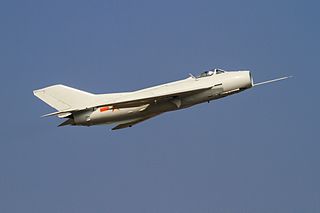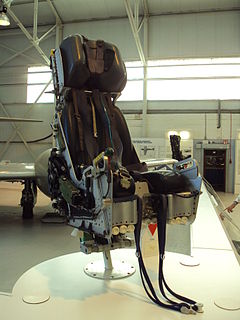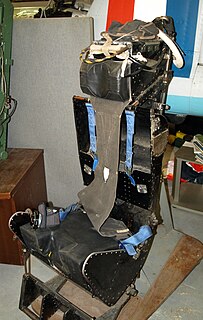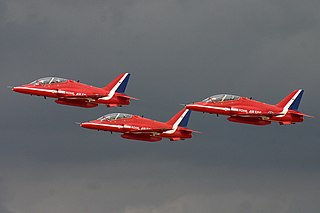
The Aermacchi or Macchi MB-326 is a light military jet trainer designed in Italy. Originally conceived as a two-seat trainer, there have also been single and two-seat light attack versions produced. It is one of the most commercially successful aircraft of its type, being bought by more than 10 countries and produced under licence in Australia, Brazil and South Africa. It set many category records, including an altitude record of 56,807 ft on 18 March 1966. More than 800 MB-326s were constructed between 1961–1975.

The Shenyang J-6 is the Chinese-built version of the Soviet MiG-19 'Farmer' fighter aircraft, the world's first mass-produced supersonic aircraft.

In aircraft, an ejection seat or ejector seat is a system designed to rescue the pilot or other crew of an aircraft in an emergency. In most designs, the seat is propelled out of the aircraft by an explosive charge or rocket motor, carrying the pilot with it. The concept of an ejectable escape crew capsule has also been tried. Once clear of the aircraft, the ejection seat deploys a parachute. Ejection seats are common on certain types of military aircraft.
Martin-Baker Aircraft Co. Ltd. is a British manufacturer of ejection seats and safety-related equipment for aviation. The company's origins were originally as an aircraft manufacturer before becoming a pioneer in the field of ejection seats. The company's headquarters are in Higher Denham, Buckinghamshire, England with other sites in France, Italy and the United States.

The Short Tucano is a two-seat turboprop basic trainer built by Short Brothers in Belfast, Northern Ireland. It is a licence-built version of the Brazilian Embraer EMB 312 Tucano.

The Avioane Craiova IAR-93 Vultur (Vulture) is a twinjet, subsonic, close support, ground attack and tactical reconnaissance aircraft with secondary capability as low level interceptor. Built as single-seat main attack version or combat capable two-seat version for advanced flying and weapon training, it was developed as a joint Yugoslav-Romanian project in the 1970s for the air forces of both nations. The Romanian aircraft were built by I.R.Av. Craiova as IAR-93, and its Yugoslav counterpart by Soko as the Soko J-22 Orao. For Romania, the IAR-93 was intended to replace MiG-15s and MiG-17s in the fighter-bomber role.

The BAC 167 Strikemaster is a British jet-powered training and light attack aircraft. It was a development of the Hunting Jet Provost trainer, itself a jet engined version of the Percival Provost, which originally flew in 1950 with a radial piston engine.

The Soko G-4 Super Galeb, also referred to as N-62, is a Yugoslav single-engine, advanced jet trainer and light ground-attack aircraft designed by the Aeronautical Technical Institute at Žarkovo and manufactured by the SOKO aircraft factory in Mostar.

The AIDC AT-3 Tzu Chung is an advanced jet trainer operated by the Republic of China Air Force (ROCAF). A total of sixty-two aircraft were manufactured by the Aerospace Industrial Development Corporation of Taiwan in collaboration with American aircraft manufacturer Northrop between 1984 and 1990. Two A-3 single-seat attack version were also built.
The Kaman KSA-100 SAVER is an American aircraft-stowable gyroplane escape device designed and built by the Kaman Aerospace Corporation for the United States Navy. Designed to be used in naval combat aircraft to deploy as part of the ejection sequence, only one was built and it did not enter service. It was the first jet-powered gyroplane.

The Martin-Baker Mk.7 is a British rocket-assisted ejection seat designed and built by Martin-Baker. Introduced in the mid-1960s, the Mk.7 has been installed in combat aircraft worldwide.

The Martin-Baker Mk.6 is a British rocket-assisted ejection seat designed and built by Martin-Baker. Introduced in the 1960s, the Mk.6 has been installed in combat and training aircraft worldwide.

The Martin-Baker Mk.5 is a British ejection seat designed and built by Martin-Baker. Introduced in the late 1950s, the Mk.5 has been installed in combat and training aircraft worldwide.

The Martin-Baker Mk.4 is a British ejection seat designed and built by Martin-Baker. Introduced in the 1950s, the Mk.4 has been installed in combat and training aircraft worldwide.

The Martin-Baker Mk.9 is a British rocket-assisted ejection seat designed and built by Martin-Baker. Introduced in the late-1960s, the zero-zero capable Mk.9 has been installed in several European combat aircraft types and was also used in experimental aircraft.

Martin-Baker Mk.8 is the designation given to two distinct British ejection seat types designed and built by Martin-Baker. The original use applies to a seat developed for the cancelled BAC TSR-2 strike aircraft project of the 1960s, re-use of the designation applies to a lightweight version of the Martin-Baker Mk.10 seat for the Short Tucano and other similar military training aircraft.

The Martin-Baker Mk.1 is a British ejection seat designed and built by Martin-Baker. Developed in the late 1940s it was the first in the line of production Martin-Baker seats for military aircraft. Ground and air testing of earlier designs resulted in the first successful test ejection of a company employee in July 1946. A seat type designed for the Saunders-Roe company was known as the Pre-Mk.1.

The Martin-Baker Mk.2 is a British ejection seat designed and built by Martin-Baker. Introduced in the early 1950s, the Mk.2 was developed from the Martin-Baker Mk.1, the main improvement being automatic parachute deployment.

Flight Lieutenant Sean Cunningham was a Royal Air Force pilot on the Red Arrows aerobatics display team, who died when his ejection seat initiated whilst the aircraft he was in was stationary on the ground and he was conducting pre-flight checks. The incident occurred at the Red Arrows' home base, RAF Scampton in Lincolnshire, England. The initiation of the ejection seat was assumed to be by accident. The parachute on the seat did not deploy and Cunningham fell, still strapped to the seat, 220 feet (67 m) to his death 217 feet (66 m) away from the motionless aircraft. In January 2018, in the prosecution brought by the Health and Safety Executive, Martin-Baker, the manufacturers of the seat, pleaded guilty to a breach of health and safety law regarding Cunningham's death. On 23 February 2018, Martin-Baker were fined £1.1 million.

















